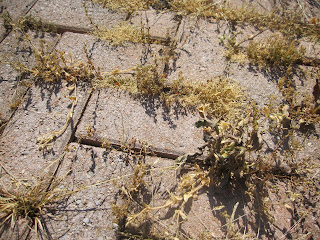In the past the norm was to use things like RoundUp, which though very effective and specific, were expensive and used harmful chemicals which had adverse effects to the surrounding environment. Resent legislation in Ontario has made it pretty much illegal to use these past products for none commercial/agricultural purposes and even more so in places that are environmentally protected like The Moran or Niagara Escarpment. This has left many people without many options has to control the growing weed infestation. Many natural products are available, but they are often expensive, costing anywhere between $20 - $50+ per bottle and aren't often specific, killing pretty much everything. Products like RoundUp were used because they only killed unwanted weeds. Additionally, many companies have converted over and now offer natural methods solutions as well but they can cost $100 - $1000+ depending on your acreage.
The easiest and cheapest way to remove unwanted weeds is to physically remove them, but it often ruins you lawn with holes and can sometimes results in more weeds growing where their fallen comrades once grew. It is also labour intensive and if you have a large property pretty much impossible to remove them all on your own.
The solution, though not specific in its killing ability, is effective, cheap, nontoxic and can be used for your dinner (minus the soap). The weed killing mix consists on nothing more then white vinegar, salt and liquid dish detergent. If you search around the web you will find many different ratios of the three, but below are two different mixtures I made up and I found most effective.
Instructions (Hand held sprayer)
 |
| Created 4 batches and only cost $20 at the grocery store |
- Pour 4-5 cups (0.95 - 1.18L) of white vinegar
- Add 1/4 cup of salt
- Add 1 tbsp of liquid dish detergent
- Mix it all together (Stir/shake)
- Spray directly onto weeds or pour into cracks
- Pour 1 Gallon (3.79L) of white vinegar
- Add 1 cup of salt
- Add 2 tbsp of liquid dish detergent
- Mix all together (stir/shake)
- Spray directly onto weeds or pour into cracks
Recommendations:
- Best applied on hot sunny days, in direct sunlight and with little cloud cover
- Not as effective in cloudy conditions
- DO NOT apply if it calls for rain or is raining since the rain water will only wash the mixture off the now happy weeds.
- This mixture is not toxic, but will burn if you get it into your eyes, open cuts, nose or mouth.
- This will kill most vegetation so be careful when spraying around the lawn or other plants
- The acetic acid found in vinegar can make your soil acidic. Most plants don't grow well in acidic conditions. If you have a more alkaline soil conditions the vinegar may help make it more natural.
- If using on the lawn be sure to use a sprayer which can be adjusted to a straight stream and ONLY spray the weed itself. If you get some on the grass blades around the weeds that is okay because the grass blades will regrow. I would also suggest ditching the salt, since this can have a detrimental effect on your soil quality.
 |
| Look how happy they all look |
 |
| Plant should have kept hydrated when in the sun for 5 hours |
Simple table salt is made up of sodium chloride and are important macromolecules in our diet for things like never conduction and the regulation of fluid balance within out bodies. Water likes to follow sodium, something a plant already loosing water doesn't want present. The presence of salt literally only adds salt to injury by drawing out more water from the already drained plant. The salt also has an added effect of disrupting the uptake of important compounds and reducing the ability to absorb water effectively through the plants root system. There's a reason why salt water spewing hurricanes and tsunamis destroy farm land. This adverse effect on soil is why I would suggest ditching the salt when applying to your lawn.
 |
| Nice and crispy after 24 hours |
Liquid dish detergent is probably one of the strangest parts to this mixture, but it is very crucial though it is in the smallest quantity. Liquid dish detergent is made up of a series of surfactants. These surfactants make sure the vinegar gets up nice and close the plant and sticks to it. Liquid dish detergent can also be used as an effect pesticide, but I will save that for a later article.
So there you have it, a natural weed killer you can literally cook up in your own kitchen. Try out